
Animals that start with V include mammals such as vampire bat, vervet monkey, Virginia opossum, volcano rabbit and Visayan warty pig; birds such as vultures, vireos and the velvet asity; insects such as the viceroy butterfly, and fish such as the viperfish.
On this page you’ll meet these and many other interesting animals beginning with v, together with pictures and facts on each animal.
Below many of the animals you’ll find links that you can follow for further information, pictures and videos.
Included in this list are individual species (e.g., vervet monkeys) and well-known groups of species (e.g., vultures) whose names begin with V. The scientific name and conservation status are provided for each of the individual species.
List of Animals Beginning With V
1. Vampire Bat (Common)

- Scientific name: Desmodus rotundus
- Type of animal: Mammal
- Family: Phyllostomidae
- Subfamily: Desmodontinae
- Where found: Central America, South America
- Conservation status: Least Concern
The common vampire bat is one of three vampire bat species (the others being the hairy-legged vampire bat and white-winged vampire bat). All three vampire bats are found in Central and South America.
Vampire bats are infamous for their habit of feeding on the blood of other animals. The scientific name for this behavior is hematophagy.
Like all bats, vampire bats are mammals (and therefore, despite having wings, are not related to birds). A bat’s wings are spread out on elongated finger bones.
The common vampire bat is found from southern Mexico to central Argentina and Chile in South America. It lives in grassland and woodland habitats. During the day, the bat sleeps in large roosts in caves and deserted buildings.
The vampire bat usually feeds on sleeping animals, with mammals (in particular, livestock) being its most common victims.
Using heat sensors in its nose, the bat can locate where blood is flowing closest to its victim’s skin. It can walk (and even jump), using its folded wings as legs.
Using its razor-sharp incisor teeth, the vampire bat makes an incision in its victim’s skin, then proceeds to drink. The bat’s saliva contains anticoagulant chemicals that prevent its victim’s blood from clotting.
The vampire bat takes relatively little blood, and its bite alone causes its victims no permanent harm. However, the species is known to spread disease.
Discover More…
You can find out more about vampire bats here: Vampire Bat Facts
You can find out more about bats on this page: Bats: The Ultimate Guide
You can find out more about the different types of mammals on this page: Types of Mammal
2. Vampire Squid
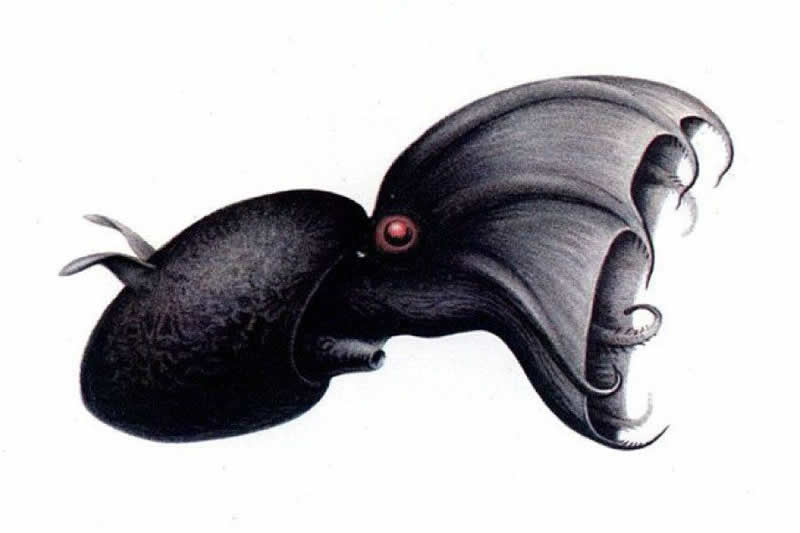
- Scientific name: Vampyroteuthis infernalis
- Type of animal: Cephalopod
- Family: Vampyroteuthidae
- Where found: tropical and subtropical waters
- Conservation status: Unassessed
The vampire squid is a cephalopod (a member of the class Cephalopoda, a group that contains animals such as squid, cuttlefish and octopuses).
Despite its name, the vampire squid is not a true squid, and this eight-legged sea animal is more closely-related to octopuses. It represents the only known species of order Vampyromorphida.
A deep-sea species, the vampire squid is found at depths of up to 900 meters (3,000 ft.) in tropical and sub-tropical oceans.
The vampire squid is dark red in color, and has large, blue-colored eyes. Its eight arms are connected by webbing. It has two fins and two feelers. The feelers can be withdrawn into the animal’s cloak-like webbing. The vampire squid is around 30 cm / 1 ft. in length.
Although unable to produce ink like other squid, the vampire squid is able to produce a light-emitting mucous cloud if threatened by a predator. In addition, the vampire squid’s body is covered with light-producing organs, which can also be used defensively to dazzle would-be predators.
The vampire squid propels itself through the water either with its fins, or by using a form of jet propulsion, in which water is rapidly expelled from a cavity in its body. The jet-propulsion method is more often used by younger vampire squid.
Discover More…
You can see more amazing ocean animals on this page: Ocean Animals List with Pictures And Facts
3. Vancouver Island Marmot
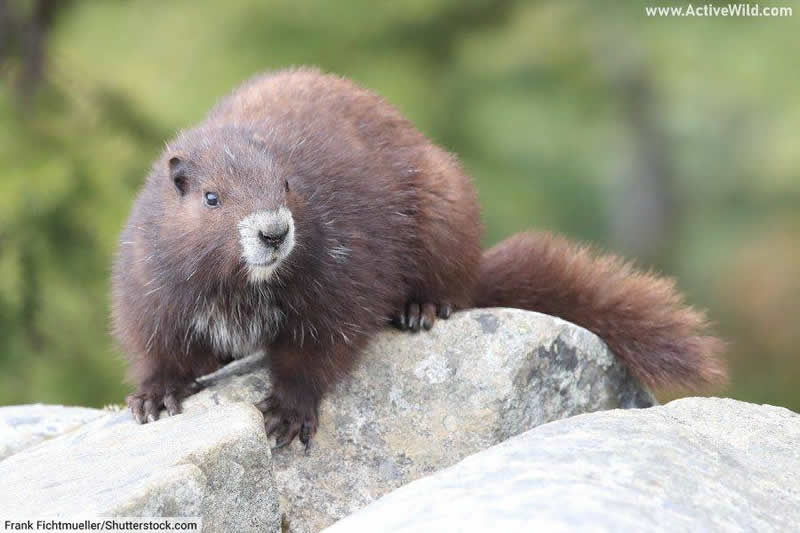
- Scientific name: Marmota vancouverensis
- Type of animal: Mammal
- Family: Sciuridae
- Where found: North America
- Conservation status: Critically Endangered
Marmots are mid to large rodents in the squirrel family, Sciuridae. The fifteen species of marmot belong to the genus Marmota. They live in grasslands and mountainous areas in Eurasia and North America, and hibernate during the winter.
The Vancouver Island marmot is Canada’s most endangered mammal. In 2017, it was estimated that the species’ wild adult population numbered just 90.
The Vancouver Island marmot has dark brown fur with white patches on the face and chest. It weighs around 5 kg / 11 lb. and reaches lengths (including tail) of around 72 cm / 2.36 ft, making it one of the largest members of the squirrel family, Sciuridae.
The rodent is endemic to (only found on) Canada’s Vancouver Island, where it inhabits subalpine meadows (meadows found just below the treeline). It lives in small groups in communal burrows.
Discover More…
You can find out more about rodents on this page: Rodent Facts
You can see more critically endangered animals on this page: Critically Endangered Species
4. Vanga
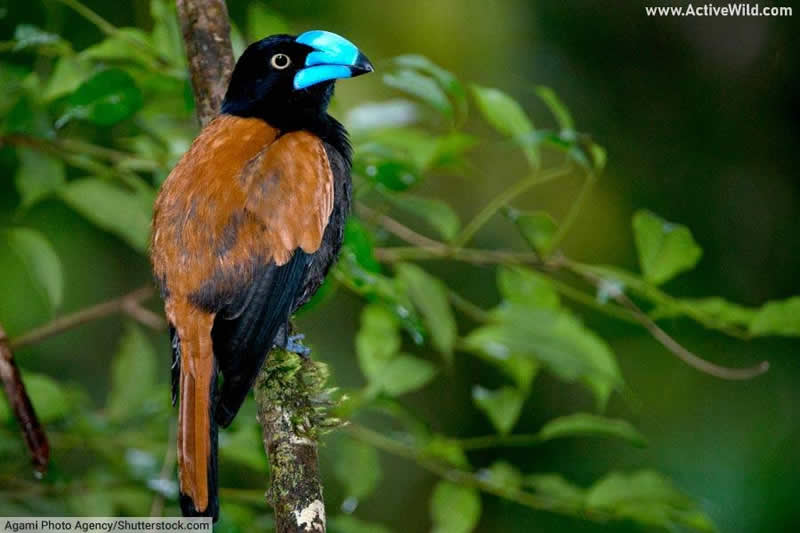
- Type of animal: Birds
- Family: Vangidae
- Where found: Africa (Madagascar)
Vangas are a group of around 15 small to mid-sized birds belonging to the family Vangidae. Most vangas have powerful, hooked bills with which they capture their prey, which includes insects, worms, and small vertebrates such as lizards and frogs.
Vangas are found on the African island country Madagascar. Other birds in the same family are found elsewhere in Africa and in Asia. (Other members of the family include the newtonias and helmetshrikes).
Each of the fifteen-or so species of vanga has evolved to fill its own ecological niche. This is an example of adaptive radiation – the evolutionary process in which multiple species evolve from a single ancestral species in order to fill different niches.
Discover More…
You can find out more about birds on this page: Bird Facts
You can find out more about the different types of birds on this page: Types of Birds
5. Vaquita
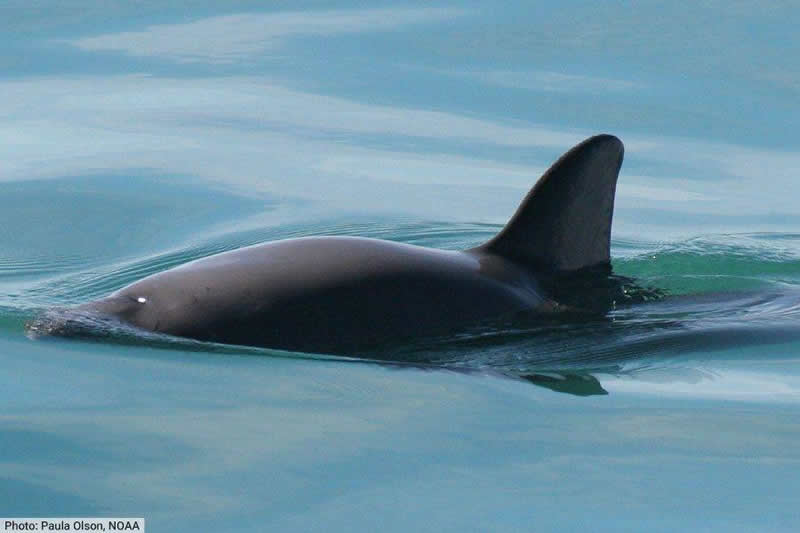
- Scientific name: Phocoena sinus
- Type of animal: Mammal
- Family: Phocoenidae
- Where found: North America
- Conservation status: Critically Endangered
The vaquita is a critically endangered porpoise found only in the Gulf of California – a small region of the Pacific Ocean that separates Baja California from mainland Mexico. Here it inhabits shallow waters and feeds on fish, squid and crustaceans.
With a body length of up to 1.5 m / 4.9 ft., the vaquita is the world’s smallest cetacean (a cetacean is a member of the group of marine mammals that includes whales, dolphins and porpoises).
The vaquita is the world’s most endangered cetacean, with a wild adult population numbering just 18 in 2017. The main cause of this marine mammal’s critically endangered status is the use of gillnets by local fishermen – a practice that continues (illegally) to this day.
Discover More…
You can find out more about the different types of mammals on this page: Types of Mammal
6. Variegated Squirrel
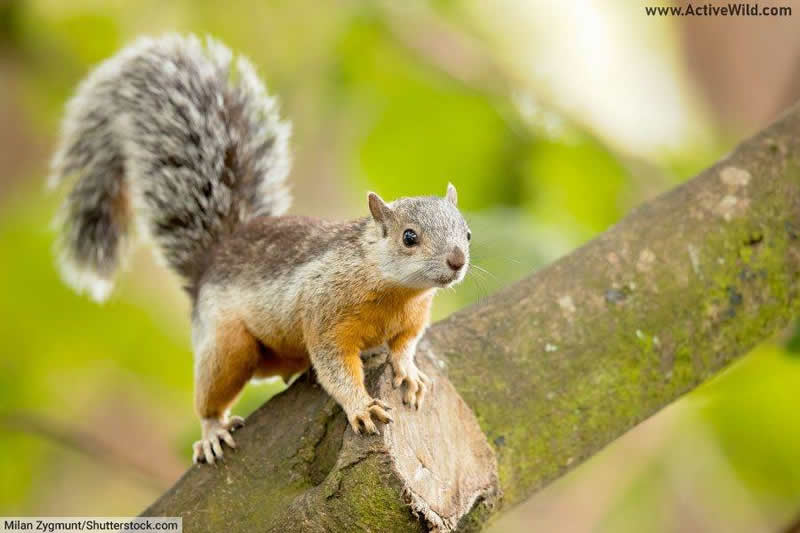
- Scientific name: Sciurus variegatoides
- Type of animal: Mammal
- Family: Sciuridae
- Where found: Central America
- Conservation status: Least Concern
The variegated squirrel is a species of squirrel common in forests throughout Central America.
The “variegated” in the species’ name refers to the different colors seen on the animal’s body. The variegated squirrel’s coat is usually predominantly brown, with darker – and often lighter – stripes running along the back and sides. The species’ coloration varies, not only in individuals from different regions, but also in individuals from the same region.
The variegated squirrel spends most of its life in the trees, and sleeps in a nest constructed from leaves. A squirrel nest is known as a drey.
Unlike many other squirrels, the variegated squirrel isn’t known to hoard food. It forages in the trees, with seeds forming the bulk of its diet. It will also eat other plant material, insects, and, occasionally, young birds.
Discover More…
You can find out more about rodents on this page: Rodent Facts
7. Velvet Asity
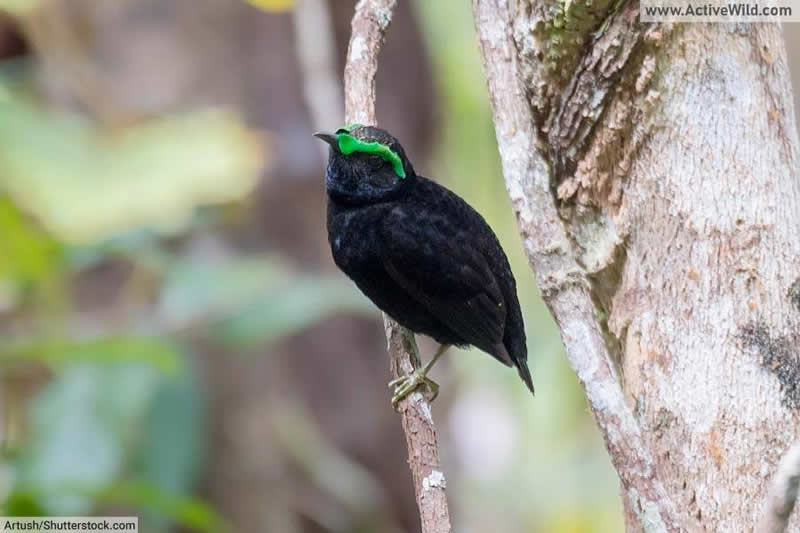
- Scientific name: Philepitta castanea
- Type of animal: Bird
- Family: Philepittidae
- Where found: Africa (Madagascar)
- Conservation status: Least Concern
The velvet asity is a bird found in the rainforests of the African island of Madagascar. It is endemic to the island, meaning that it is found nowhere else on Earth.
As is the case with many bird species, there is a marked difference in the appearance of male and female velvet asitys. Males are black, and have bright green wattles (fleshy growths) over the eye. Females are pale green with a streaked chest.
A marked difference in the coloration of males and females in the same species – such as that seen in the velvet asity – is known as “sexual dichromatism”.
The velvet asity belongs to the family Philepittidae, which contains just four species, including the velvet asity.
Discover More…
You can find out more about birds on this page: Birds: The Ultimate Guide
You can find out more about the different types of birds on this page: Types of Birds
8. Verreaux’s Sifaka
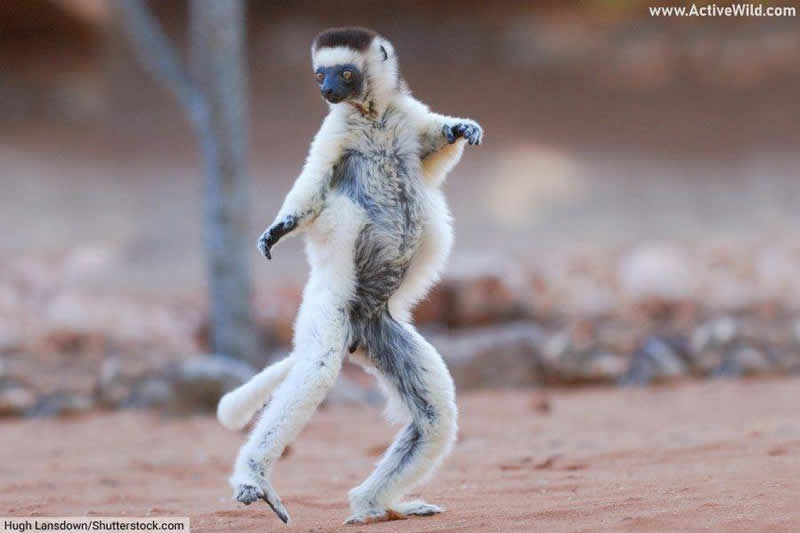
- Scientific name: Propithecus verreauxi
- Type of animal: Mammal
- Family: Indriidae
- Where found: Africa (Madagascar)
- Conservation status: Critically Endangered
Verreaux’s Sifaka is a lemur found in southern and southwestern Madagascar.
Lemurs are a group of primates that are endemic to (only found on) the African island country Madagascar. There are around 100 primate species, divided between five families.
Verreaux’s Sifaka is a mid-sized lemur with a body length of up to 45 cm (17.7 in), and tail length of up to 60 cm / 23.6 in. It has thick white fur with patches of brown on the sides and head.
Well suited for a life spent in the trees, Verreaux’s Sifaka is an expert climber and jumper. On the ground the species moves by jumping rather than by walking.
Verreaux’s Sifaka is herbivorous. It lives in small groups, foraging for leaves and fruit during the mornings and evenings, and resting during the hottest part of the day.
The main threat to this critically endangered animal is habitat loss. Logging and other agricultural activities on Madagascar have led to a large amount of deforestation.
Discover More…
You can find out more about primates on this page: Primate Facts
You can see more African animals on this page: African Animals List with Pictures & Facts
9. Vervet Monkey
- Scientific name: Chlorocebus pygerythrus
- Type of animal: Mammal
- Family: Cercopithecidae
- Where found: Africa
- Conservation status: Least Concern
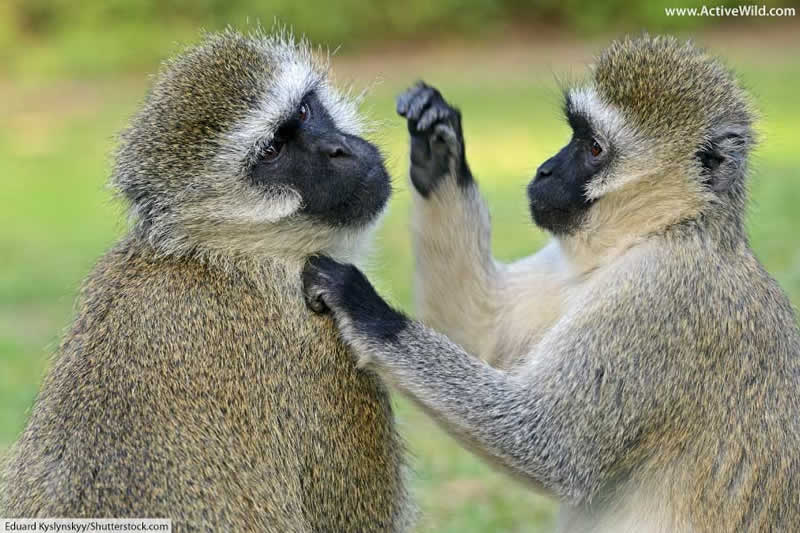
The vervet monkey is a primate found in many parts of eastern and southern Africa, where it inhabits savanna, forest and shrubland habitats. This grey haired, black-faced monkey is common throughout most of its range, and has the conservation status ‘Least Concern’.
The vervet monkey has four main predators: leopards, eagles, pythons, and baboons; the monkey has a different alarm call for each.
An omnivore, the vervet monkey eats a variety of plant material, including gum and leaves, as well as insects and bird nestlings.
Discover More…
You can find out more about monkeys on this page: Monkeys Ultimate Guide
You can see more monkeys on this page: List of Monkeys with Pictures & Facts
You can see more African animals on this page: African Animals List with Pictures & Facts
10. Viceroy Butterfly
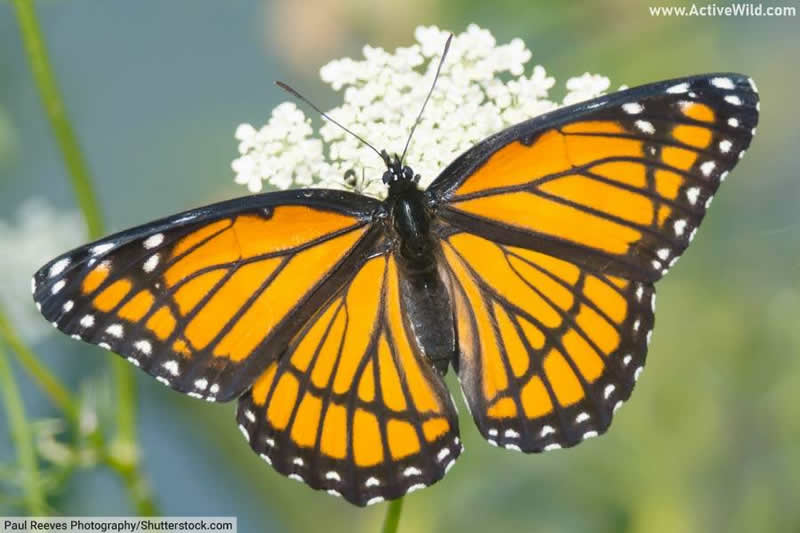
- Scientific name: Limenitis archippus
- Type of animal: Insect
- Family: Nymphalidae
- Where found: North America
- Conservation status: Least Concern
The viceroy butterfly has deep orange wings with black veins, and looks very much like a monarch butterfly. (The viceroy is slightly smaller, and has an extra black line running perpendicular to the body across the hindwing.)
Both the viceroy and the monarch are distasteful to predators. The similarities in the viceroy and monarch’s coloration are an example of Müllerian mimicry – a phenomena in which different species with the same defensive features (i.e., the butterflies’ toxicity) come to resemble one another. This is mutually beneficial for all of the similar-looking species, as predators learn to avoid any animal with those characteristics.
Viceroy caterpillars are usually found on willows. Adults can be seen from April to December.
The viceroy is one of around 6,000 species in the family Nymphalidae. Nymphalidae is the largest butterfly family. Due to their reduced front legs, butterflies in this family can appear to only have four, rather than six, legs.
Discover More…
You can find out more about insects on this page: Insects Ultimate Guide
You can find out more about the monarch butterfly on this page: Monarch Butterfly Facts
11. Vicuña
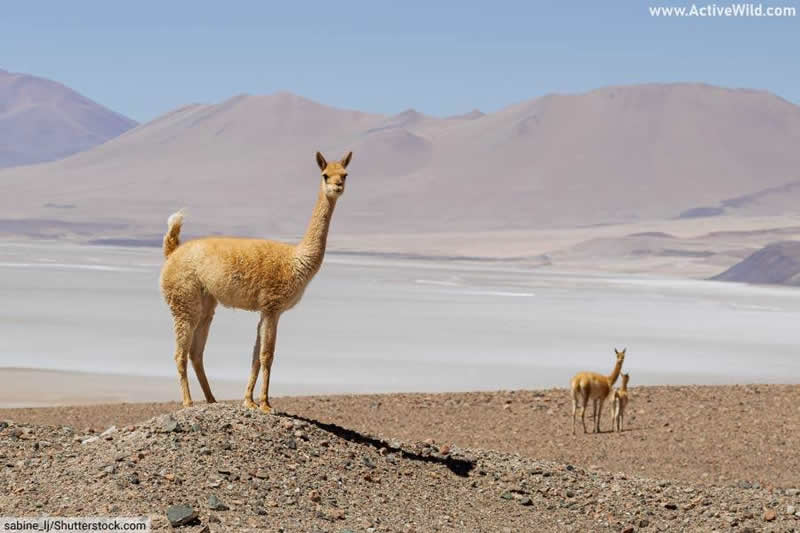
- Scientific name: Vicugna vicugna
- Type of animal: Mammal
- Family: Camelidae
- Where found: South America
- Conservation status: Least Concern
The vicuña is a hooved mammal found in South America. It is a member of the camel family Camelidae, and related to the alpaca and llama, both of which are domesticated.
(The only other wild member of the camel family found in South America is the guanaco (Lama guanicoe).
The vicuña is believed to be the wild ancestor of the closely-related alpaca, which was first domesticated at least 2,000 years ago.
The vicuña lives at high altitudes in the Andes, and is present in Argentina, Bolivia, Chile, Ecuador and Peru. Its wool is highly valued (the species’ domestic ancestor, the alpaca, was bred for its wool). The species is the national animal of Peru.
The vicuña became endangered in the 1970’s, when its population shrank to around 6,000 individuals as a result of overhunting.
The species’ comeback since then is a conservation success story. Today the vicuña’s conservation status is ‘Least Concern’, and its adult population numbers around 350,000.
Discover More…
You can find out more about mammals on this page: Mammal Facts
You can find out more about the different types of mammals on this page: Types of Mammal
12. Viper
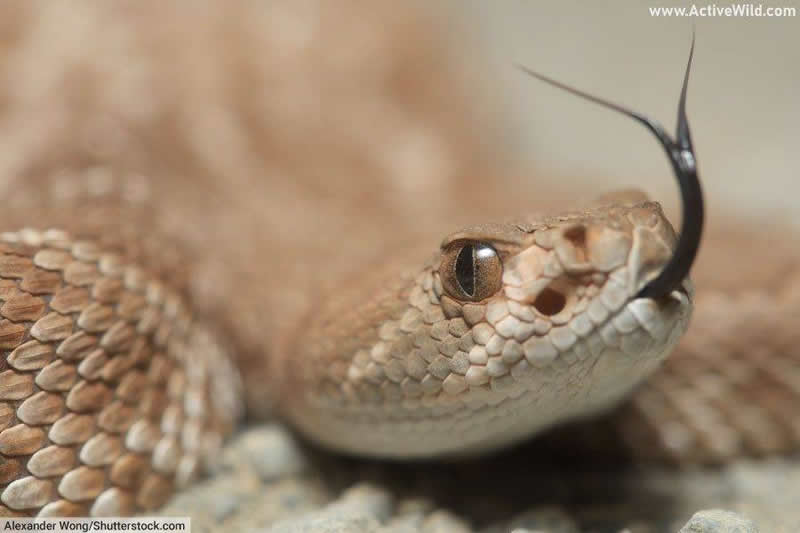
- Type of animal: Reptile
- Family: Viperidae
- Where found: Worldwide, except Australia and Antarctica
- Conservation status: Various
Vipers are venomous snakes that make up the family Viperidae. There are around 374 species in the family. Vipers are found on every continent except for Australia and Antarctica (vipers are also missing from several islands and island countries, including Madagascar and Ireland).
All vipers have a pair of hollow fangs that are used to inject venom. The fangs fold backwards when not in use, and are only revealed as the animal strikes.
There are three main types of viper: Feas’ vipers, of subfamily Azemiopinae; pit vipers of subfamily Crotalinae; and true vipers of subfamily Viperinae.
With 271 species, the pit vipers are the most numerous subfamily of vipers. Pit vipers have heat-sensing “pit organs” between their eyes and their nostrils, giving them a “sixth sense” for finding prey.
Examples of pit vipers include all rattlesnakes, the bushmaster, and the sidewinder.
The world’s largest viper is the Gaboon viper, which is found in African rainforests. It has the longest fangs, and carries the highest amount venom, of any snake.
Discover More…
You can find out more about reptiles on this page: Reptiles Ultimate Guide
You can see more snakes on this page: Types of Snake with Pictures & Facts
13. Viperfish

- Type of animal: Fish
- Family: Stomiidae
- Genus: Chauliodus
- Where found: The bathyal zone
- Conservation status: Various
Viperfish are nine species of predatory deep sea fish of genus Chauliodus. They have large fangs which can be folded back to allow the fish’s mouth to close.
Viperfish lure their prey in by producing light with organs called photophores. These are located both on the underside and the dorsal fin of the fish. When the victim is close enough, the viperfish strikes with its fearsome jaws!
Viperfish inhabit the bathyal zone. Sunlight does not reach this part of the ocean, which is between 1,000 to 4,000 m (3,300 to 13,100 ft) below sea level.
In this dark, cold environment, the viperfish hunts its prey, which includes shrimp, small fish, and squid.
Discover More…
You can see more ocean animals on this page: Ocean Animals with Pictures & Facts
14. Vireo
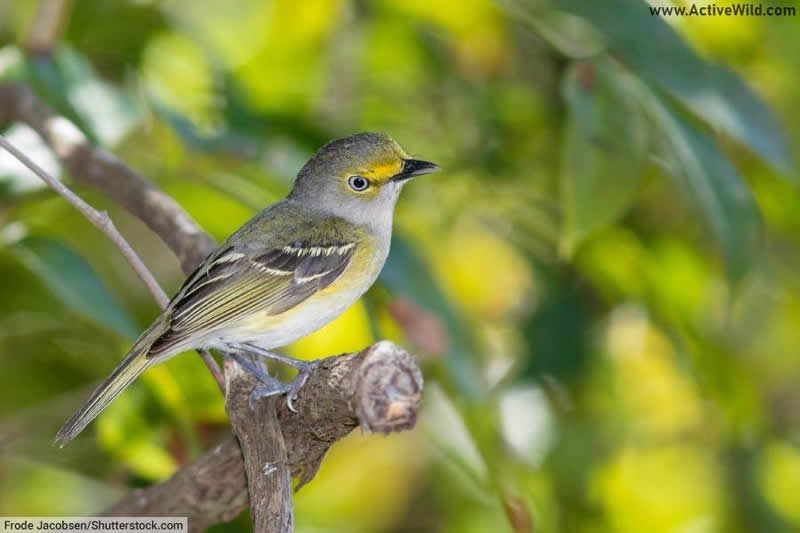
- Type of animal: Bird
- Family: Vireonidae
- Where found: The Americas, Asia
- Conservation status: Various
Vireos are a family of around 60 species of small songbirds, most of which are found in the Americas. A characteristic of birds in this family is a strong bill which is slightly hooked at the tip. Many vireo species have ‘spectacle-like’ markings on their faces.
Birds of genus Vireo, which contains 32 species, are known as “true” vireos. The true vireos are found in the Americas, and most are migratory. They build cup-like nests from spider webs and grass.
Discover More…
You can find out more about birds on this page: Birds Ultimate Guide
You can find out more about the different types of birds on this page: Types of Birds
15. Virginia Opossum
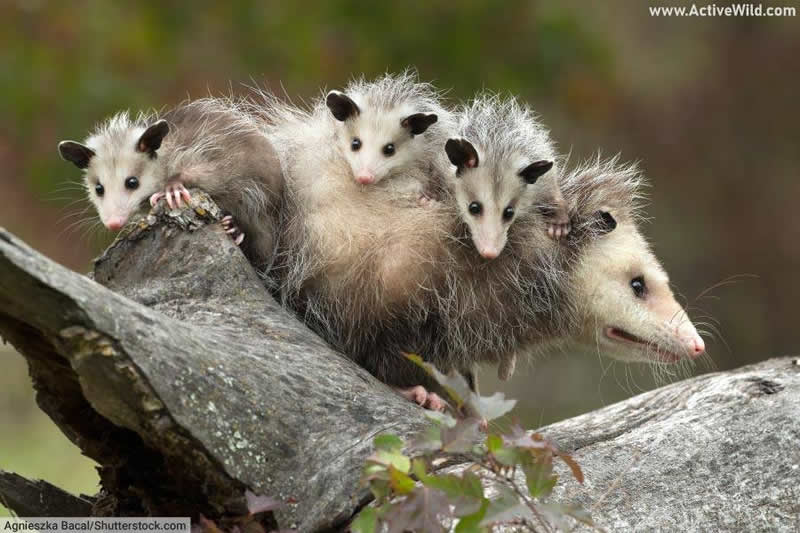
- Scientific name: Didelphis virginiana
- Type of animal: Mammal (marsupial)
- Family: Didelphidae
- Where found: North America (including Central America)
- Conservation status: Least Concern
The Virginia opossum is a cat-sized marsupial found in North America. It is the only marsupial found north of Mexico, and the marsupial found the furthest north.
Marsupials are mammals whose young are born in a relatively underdeveloped state (compared to placental mammals such as dogs, cats, whales, humans, etc.).
Newborn marsupials, which are known as “joeys”, undergo further development in a special pouch in the mother’s body. Here they receive shelter, protection, and milk (all mammals feed their offspring with milk).
Virginia opossum infants emerge from their mother’s pouch after around ten weeks. They are then carried around on the mother’s back until able to fend for themselves.
Although most of the world’s marsupials are today found in Australia, the first true marsupials appeared in the Americas.
Discover More…
You can find out more about Virginia opossums on this page: Virginia Opossum facts
You can see more marsupials on this page: List of Marsupials with Pictures and Facts
Discover more North American animals on this page: North American Animals Pictures & Facts
16. Visayan Spotted Deer
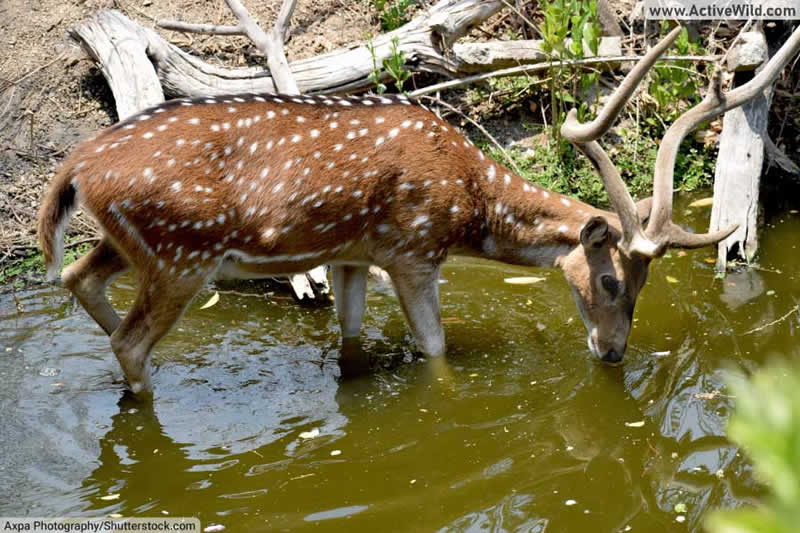
- Scientific name: Rusa alfredi
- Type of animal: Mammal
- Family: Cervidae
- Where found: Asia
- Conservation status: Endangered
The Visayan spotted deer is an endangered deer only found in the Western Visayan Islands of the central Philippines. It inhabits the island’s dense rainforests, where it feeds on grass and leaves in forest clearings.
Although small and short-legged, the Visayan spotted deer is relatively well-built. Its back and sides are dark brown and marked with pale spots. Its undersides are white.
An endangered species, the Visayan spotted deer’s adult population is thought to number 700. The primary threat to the species is habitat loss caused by deforestation. The deer is also hunted for food by locals.
Discover More…
You can see more rainforest animals on this page: Rainforest Animals List with Pictures & Facts
You can find out more about mammals on this page: Mammals Ultimate Guide
17. Visayan Warty Pig
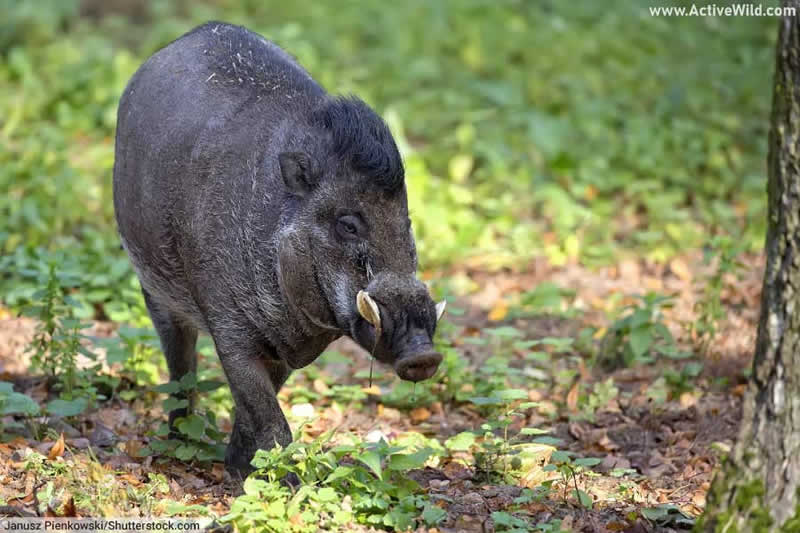
- Scientific name: Sus cebifrons
- Type of animal: Mammal
- Family: Suidae
- Where found: Asia
- Conservation status: Critically Endangered
The Visayan warty pig is a wild pig found on the Visayan islands of Negros, Panay and possibly Masbate (where it was last seen in 1993) in the central Philippines.
Like all pigs, the Visayan warty pig is a member of the family Suidae and the genus Sus. (Species in the family Suidae that aren’t in this genus include warthogs and the babirusa.)
The Visayan warty pig is small, and typically pig-like in appearance, with a barrel-shaped body, long snout, short legs and a short tail.
On its snout are six fleshy, wart-like growths, which give the species its name. The warts may provide protection from an opponent’s tusks during a fight.
The Visayan warty pig is critically endangered due to over-hunting and deforestation.
Discover More…
You can see more rainforest animals on this page: Rainforest Animals List with Pictures & Facts
You can find out more about mammals on this page: Mammals The Ultimate Guide
18. Vizsla

- Scientific name: Canis familiaris, Canis lupus familiaris
- Type of animal: Mammal
- Family: Canidae
- Where found: First bred in Hungary
- Conservation status: Domestic
The Vizsla is a domestic dog breed from Hungary. It is a short-haired, mid-sized hunting dog with red-brown hair.
Since becoming domesticated, the domestic dog has been selectively bred in order to produce breeds that are suited for performing certain tasks.
This explains the large diversity of dog types; small dog breeds may have been bred for catching rats, while larger breeds may have been bred for protective duties.
The Vizsla is a pointer – a type of gun dog whose natural instinct to “point” at game (by standing still and looking at its target) has been reinforced by years of selective breeding.
The Domestic dog is either considered to be species in its own right, or a subspecies of gray wolf. If the former, its scientific name is Canis familiaris; if the latter, its scientific name is Canis lupus familiaris (the three-word name indicating that it is a subspecies).
Discover More…
You can find out more about dogs on this page: Dog Facts
You can see EVERY species of dog on this page: Wild Dog Species List with Pictures and Facts
19. Vlei Rat
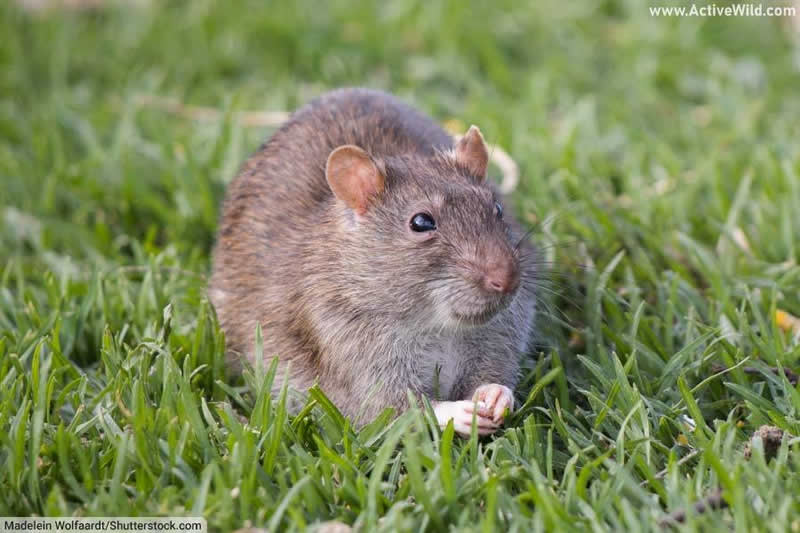
- Type of animal: Mammal
- Family: Muridae
- Where found: Africa
- Conservation status: Various
Vlei rats are rodents of the genus Otymys (a genus is a group of closely-related species). All 26 species of vlei rats are found in Sub-Saharan Africa (i.e., the area south of the Sahara desert).
The vlei rats’ name comes from the Afrikaans word “vlei”, which means a shallow, seasonal lake. (There is also a vlei frog.) Afrikaans is a language widely spoken in southern African countries.
Vlei rats are members of the subfamily Murinae, which is home to all rats and mice.
Like all rodents, vlei rats have incisors that grow continuously through the animal’s lifetime – this prevents the teeth from being worn down by constant gnawing on tough plants.
Discover More…
You can find out more about mammals on this page: Mammals Ultimate Guide
20. Volcano Rabbit
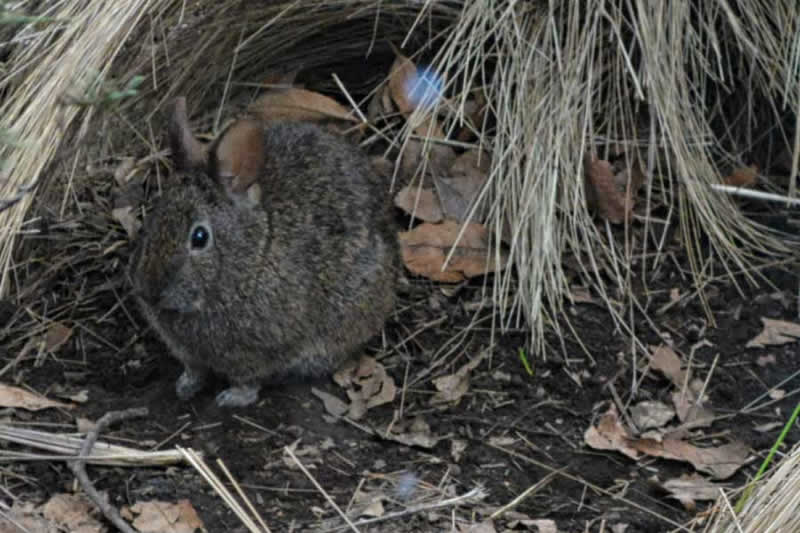
- Scientific name: Romerolagus diazi
- Type of animal: Mammal
- Family: Leporidae
- Where found: Mexico
- Conservation status: Endangered
The volcano rabbit is a species of rabbit endemic to (only found in) Mexico. It lives in forests and grasslands on four volcanoes to the south of Mexico City.
The volcano rabbit is the world’s second-smallest species of rabbit (the pygmy rabbit, Brachylagus idahoensis is the smallest).
Rabbits, together with hares and pikas, make up the order Lagomorpha. Lagomorphs are similar to (and related to) rodents, but can be distinguished by their having four (rather than two) incisors in the upper jaw, and their almost entirely herbivorous diets.
Like rodents, lagomorphs have incisor teeth that grow continuously throughout their lifetimes. This allows them to gnaw on tough plant food without wearing down their teeth.
The volcano rabbit’s endangered status is a result of habitat loss caused by the conversion of its natural habitat to agricultural land, and urban expansion (Mexico City is North America’s most highly-populated city).
Discover More…
You can find out more about mammals on this page: Mammals Ultimate Guide
21. Vole
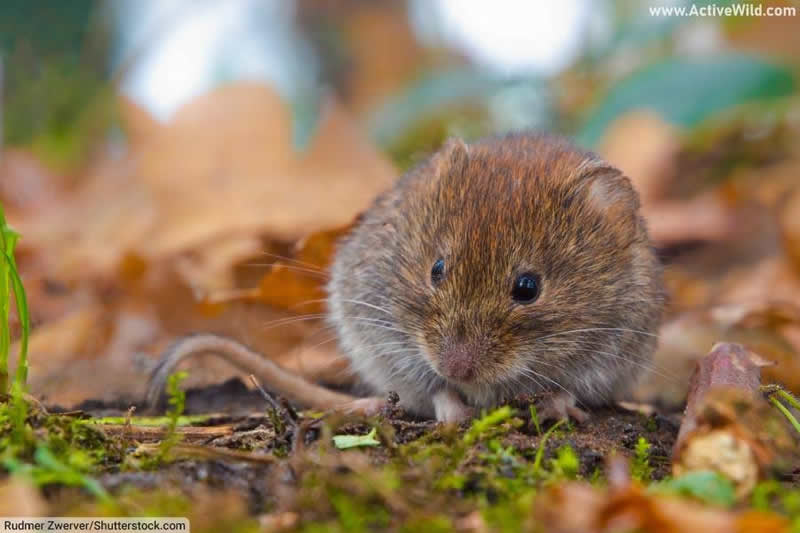
- Type of animal: Mammal
- Family: Cricetidae
- Where found: Northern Hemisphere
- Conservation status: Various
Voles are small rodents that, along with lemmings and muskrats, belong to the subfamily Arvicolinae.
(Arvicolinae is part of the family Cricetidae, which also contains hamsters and New World rats and mice.)
Voles resemble mice, but have shorter, hairier tails and smaller ears and eyes.
There are around 155 species of vole. The small rodents are an important source of food for many predators and are an important part of the food chain.
Voles are known to cause damage to crops. This is why the presence of natural vole predators such as the barn owl is often welcomed by farmers.
Archaeologists use the presence of vole teeth to judge the age of a site.
Discover More…
You can find out more about mammals on this page: Mammals Ultimate Guide
22. Vulture
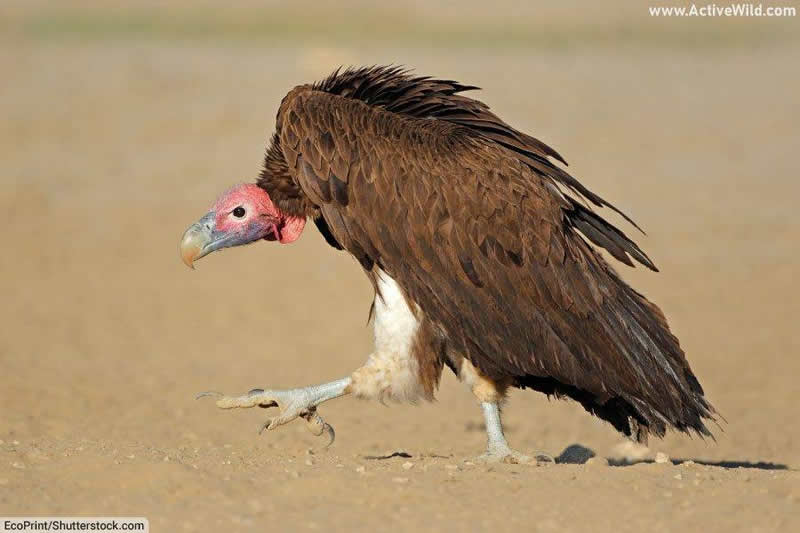
- Type of animal: Bird
- Family (Old World vultures): Accipitridae
- Family (New World vultures): Cathartidae
- Conservation status: Various
Some of the best-known animals that start with V are vultures. Vultures are birds of prey that specialize in scavenging carrion (the remains of dead animals).
There are two main groups of vultures: Old World vultures, which are found in Europe, Asia and Africa; and New World vultures, which are found in the Americas.
The Old World vultures belong to the family Accipitridae, which also contains birds of prey such as eagles and hawks.
New World vultures make up their own family, Cathartidae.
Whereas Old World vultures hunt by sight alone, New World vultures also have an acute sense of smell with which they find food.
Despite similarities in their appearance and behavior, New World and Old World vultures are not closely related. Their similarity is an example of convergent evolution – the phenomenon in which unrelated species evolve similar characteristics.
Discover More…
You can find out more about birds on this page: Birds Ultimate Guide
You can find out more about the different types of birds on this page: Types of Birds
Animals That Start With V: Conclusion
We hope that you’ve discovered some interesting animals with names beginning with v on this page. You can find out more about the animal kingdom on the following pages:
Discover more animals in our A to Z animals section by clicking on the letters below…
Discover more about animals…
Animals: The Ultimate Guide To The Animal Kingdom
The post Animals That Start With V: New Pictures & Facts 2022 appeared first on Active Wild.


























